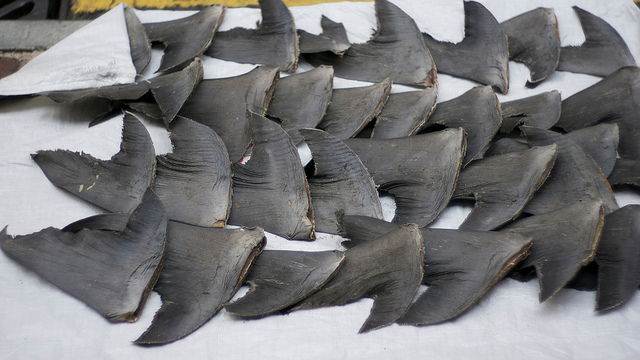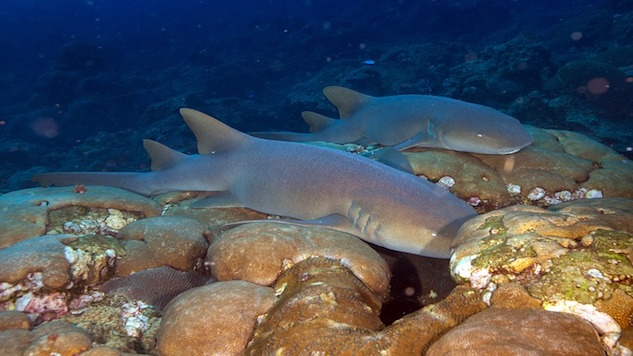
Shark fins are no longer allowed on China Air cargo planes. The announcement made international headlines when it imposed the ban for all future cargo. Considering that China is the world’s largest consumer of shark fins (Hong Kong handles 50-80 percent of the world shark fin trade), this move could appear significant. However, the airline isn’t a major player in the trade, so the move is largely symbolic. But it’s an important symbol for those trying to curtail what is seen as a destructive and unnecessary practice akin to the ivory trade.

The trade in shark meat has skyrocketed, but global commodity labelling isn’t standardized so it’s impossible to collect data on any part of the shark trade. A container labelled “shark meat” could contain any part of any species of shark. Sometimes, shark products are labelled unidentified fish categories. Graphic: Courtesy of Oceana
Symbols (and shame) create pressure for change, and it seems to be working. China Southern Airlines also announced it will no longer carry shark-fin cargo, meaning half the airlines in China won’t support the trade. The bloody reality of shark-fin harvesting, called finning, is in service of little more than a status symbol. More than 70 percent of the shark fins end up as soup, a delicacy and a sign of wealth and prosperity in some Asian cultures. A single bowl can sell for upward of $100.
Finning is gaining more attention as celebrities and conservation groups bring awareness to the practice. The process is gruesome—the fins are sliced off the shark while it’s still alive and the body is dumped in the ocean. Most of these animals die due to suffocation because they can’t swim to get oxygen into their lungs, or they’re weakened and preyed upon by other fish. Sometimes the entire shark is kept and sold off in parts as steaks, leather and oil. However, the most valuable part of the shark is the fin, and the entire body requires too much storage space.
Killing vs. Watching
In the U.S., the Shark Conservation Act passed in 2010 “requires that all sharks in the United States, with one exception, be brought to shore with their fins naturally attached.” While this law essentially prohibits shark finning, it doesn’t go far enough, according to Oceana. The “international advocacy organization focused solely on ocean conservation” is actively campaigning for passage of the Shark Fin Trade Elimination Act of 2016.
“Even though shark finning is illegal in the United States, any bowl of shark-fin soup may contain imported fins from a country where shark finning is taking place,” says Mariah Pfleger, marine scientist with Oceana. “With a federal ban, the origin of a fin would not matter because there would be no fins entering the U.S. market, legally caught or otherwise.”

According to Oceana, the United States imports fins from 11 countries, five of which do not have any type of finning ban. By allowing these fins to be bought and sold, the United States is still perpetuating the problem and potentially buying fins from sharks that have not been landed in a sustainable manner. Photo: Nicholas Wang CC BY-SA 2.0.
The legislation is another important point of pressure, according to Pfleger. While politicians might not care about being at the forefront of shark conservation, they usually are fixated on money. And the trade-off between the small sums of the import/export trade compared to billion-dollar ecotourism industry makes the ban look like a good economic decision.
U.S. shark fin exports are in decline, but imports are increasing, according to statistics the 2015 report of the Food and Agriculture Organization of the United Nations.
2000-2011: imported an average of 36 tons ($1.3 million) each year
2012: imported 44 tons ($2.5 million)
2000-2011: exported an average of 171 tons ($3.4 million) per year
2012: total exported 51 tons (86 percent decline)
During that same period, ecotourism U.S. has increased dramatically – shark tourism in particular “generated over $221 million and fueled over 3,700 jobs in 2016, which was more than 200 times the value of shark-fin exports for the entire U.S. in 2015,” says Pfleger.
“Shark tourism is a growing industry; however, the demand for shark fins, as a contributor to the global decline of sharks, can threaten ocean-based tourist economies. People all over the world are recognizing the beauty and importance of these creatures, and are increasingly seeking opportunities to interact with sharks through diving and snorkeling.”
U.S. consumer spending for 2005 on ecotourism was $24.2 billion. Global ecotourism spending was estimated at more than $453 billion in 2009, according to The World Tourism Organization.
In 2013 global spending on ecotourism was estimated at $263 billion and the number is growing. The Oceana report Shark Fin Trade: Why it Should be Banned in the United States states that “shark watchers (alone) spend an estimated $314 million on shark ecotourism every year, and researchers expect that to double to $780 million in 20 years.”
Healthy Ocean Ecosystem
The world’s oceans are an important source of food as well as a place of recreation and beauty for billions of people. But it can only remain so if care is taken to maintain a healthy balance of resources, including sharks. Some species are the sole predators of certain marine mammals, reptiles and seabird populations that would otherwise grow unchecked. Some species feed coral reefs, keeping them healthy, by removing invasive species, cycling nutrients (via their waste) and scavenging reefs to help keep them clean. This makes a strong shark population critical to maintaining the marine food chain and the availability of essential seafood.
There are 400 species of sharks swimming the oceans; of those, 100 are on the International Union for Conservations of Nature (IUCN) list of endangered species because “many of these shark species are so overexploited that even their long-term survival can no longer be guaranteed.”

Nurse sharks are found in the warm, shallow waters of the western Atlantic and eastern Pacific oceans. They are abundant throughout their range and have no special conservation status, although the closeness of their habit to human activities is putting pressure on the species. Photo: skeeze
“Scientists estimate sharks are killed, on average, 30 percent faster than they can reproduce, and some shark species are now absent where they were once common,” says Pfleger. “For hundreds of millions of years, they have played a vital role in maintaining healthy oceans. Unless we take the necessary steps to protect sharks, we may be on a path toward eliminating some of these amazing predators that help keep our oceans healthy and help generate millions of dollars every year.”
Sharks are yet another victim outdated fishing practices that threaten to destroy the very resource they purport to value.
“Some species are regarded as more valuable than others. These include hammerheads, tiger sharks, and oceanic whitetip sharks,” says Pfleger. “Of the 14 most popular species in the Hong Kong fin trade, the global center of the trade, more than 70 percent face the threat of extinction. Some shark populations have declined by more than 90 percent in recent decades due to overfishing.”
Top photo by James Whiting CC BY 2.0
Lead image by Nicholas Wang CC BY-SA 2.0
Margo is a science writer poking her nose into everything that piques her curiosity, from NASA and sea turtles to climate change and green tech. She write’s Paste’s biweekly Sustainability Report.